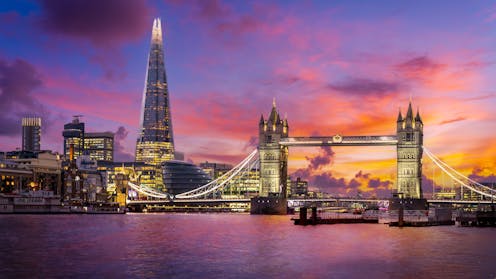Source: The Conversation – UK – By Adriana Alcaraz-Sanchez, Postdoctoral Fellow in Philosophy of Mind and Cognitive Science, University of Edinburgh
For some people, sleep brings a peculiar kind of wakefulness. Not a dream, but a quiet awareness with no content. This lesser-known state of consciousness may hold clues to one of science’s biggest mysteries: what it means to be conscious.
The state of conscious sleep has been widely described for centuries by different Eastern contemplative traditions. For instance, the Indian philosophical school of the Advaita Vedanta, grounded in the interpretation of the Vedas – one of the oldest texts in Hinduism – understands deep sleep or “sushupti” as a state of “just awareness” in which we merely remain conscious.
Similar interpretations of deep sleep are made by the Dzogchen lineage in Indo-Tibetan Buddhism. According to their teachings, different meditative practices can be followed during wakefulness and sleep to acknowledge the “essence” of consciousness. One of those meditative practices is that of dream yoga or luminosity yoga, which enables the practitioner to recognise the states of dream and sleep. This aims to bring them to a state of “pure awareness”, a state of being awake inside sleep without thoughts, images or even a sense of self.
For western science, this state poses a conundrum. How can you be aware without being aware of something? If these reports are accurate, they challenge mainstream theories that treat consciousness as always about an object. For example, my awareness of the laptop in front of me, or the blue sky rising above my window, or my own breathing. The existence of this state pushes us to reconsider what consciousness is.
Objectless sleep experiences
My colleagues and I set out to explore what a content-free state during sleep feels like in a series of studies. We first surveyed 573 people online about unusual forms of sleep experiences, including forms of sleep consciousness that might be simpler or more minimal. For example, an awareness following the dissolution of a dream, or a bare awareness of the fact that you are sound asleep.
We then conducted in-depth interviews with 18 participants, who reported they had experienced some form of objectless sleep experiences, using a protocol inspired by the micro-phenomenological interview. This is a research tool designed to help people recall and describe subtle aspects of their experience in fine detail.
In those studies, we found a spectrum of experiences we called “objectless sleep experiences” – conscious states that appear to lack an object of awareness. In all cases, participants who alluded to an objectless sleep experience reported having had an episode during sleep that lacked sensory content and that merely involved a feeling of knowing that they were aware.

Yuri A/Shutterstock
Some of our participants’ experiences matched descriptions of conscious sleep as described in Eastern philosophical traditions; objectless and selfless, with no sense of “I” remaining. Participants reported that their selves seemed to have vanished or dissolved, a state reminiscent to that of “drug-induced ego-dissolution”, reported after the ingestion of psychedelic drug DMT, and in deep-meditative states.
Other reports from the participants in our study included a faint feeling of being “there” in an undefined state, or an awareness of “nothingness” or a “void”. A few people’s experiences involved traces of rudimentary forms of dreaming, the experience of being in a world, even if such a world appeared to be missing.
Although objectless sleep experiences like conscious sleep have mainly been linked to contemplative practices, such as dream yoga, our results indicate that people without knowledge of those practices also experienced this phenomenon. In fact, the results of our online survey did not indicate an association between engagement in meditative practices and objectless sleep experiences.
However the survey results did find that experience of lucid dreaming – which is when you realise you are dreaming but stay asleep – seemed to be correlated with objectless sleep experiences. It should be noted, though, that many participants who could lucid dream did not report objectless sleep experiences.
Read more:
I’m a lucid dream researcher – here’s how to train your brain to do it
Training for lucid sleep
The rarity of objectless sleep experiences make them difficult to study. We need training methods to induce these experiences so we can better understand them.
In our recent study, my colleagues and I tested a new induction protocol that combined meditation, visualisation and lucid dreaming techniques. Four participants learned to stay aware as they drifted into sleep and to signal that they were lucid with a pre-agreed eye movement. Portable EEG recordings, which measure the brain’s electrical activity, confirmed that some objectless states occurred during non-REM (slow-wave) sleep. Researchers believe non-REM sleep lacks the sort of complex conscious states we have while dreaming, although some other forms of sleep experiences, including simpler forms of dreaming, might occur.
Dreamless sleep and consciousness research
Currently, there is a lack of agreement among scientists about what the basis of consciousness is. Some popular views assert that consciousness arises when information is broadcast in the brain. Yet, there are still debates about which sort of information the brain needs for cognitive processing.
Objectless sleep experiences expand our picture of what it is like to be conscious during sleep. Sleep consciousness has traditionally been widely studied in relation to dreams and dream-like experiences, but recently there has been a shift in this trend.
Minimal forms of consciousness, like that displayed by objectless sleep experiences, can pave the way to refine our theories of consciousness. Their existence hints at a form of awareness stripped of content altogether. Moreover, studying these sort of experiences can help us understand altered conscious states, including deep meditation, sensory deprivation, or even mind blanking – episodes in which our mind seems to go blank or go “nowhere”.
The fact people can be aware of “nothing” while asleep might tell us more about the mind than any dream ever could.
![]()
Adriana Alcaraz-Sanchez has received research funding from the following organisations: Scottish Graduate School of Arts and Humanities (SGSAH), European Research Council (ERC), International Association for the Study of Dreams (IASD), Graduate School of the University of Glasgow, and the Institute for the Advanced Studies in Humanities (IASH) at the University of Edinburgh
– ref. Can you be aware of nothing? The rare sleep experience scientists are trying to understand – https://theconversation.com/can-you-be-aware-of-nothing-the-rare-sleep-experience-scientists-are-trying-to-understand-263142











